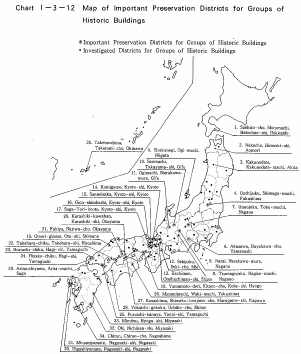| Home > Policy > White Paper, Notice, Announcement > White Paper > JAPANESE GOVERNMENT POLICIES IN EDUCATION, SCIENCE AND CULTURE 1993 > CHAPTER 3 �3 6 (4) | ||
When an application is made by those municipalities which have taken the above mentioned measures, and after inquiry to and reply from the Council for the Protection of Cultural Properties, the national government may select an entire district (or a portion thereof) which is considered to be of extremely high value to the nation as an "Important Preservation District for Groups of Historic Buildings".
When a preservation district has been selected as an Important Preservation District for Groups of Historic Buildings and deemed especially necessary, the national government may subsidize a portion of the expenses for preservation or necessary repairs to historic buildings, disaster prevention equipment and the purchase of lands or buildings that are financially supported either by the municipality itself or with assistance from the municipality.
As of July 1993, 35 districts (1.770 hectares in total) had been selected in 30 municipalities in 23 prefectures as Important Preservation Districts for Groups of Historic Buildings, with about 4,800 buildings specifically selected as Historic Buildings (Chart I 3 12). In the selected districts, preservation and repair work are being carried out according to preservation plans. Along with improving the community environment, this work contributes to the type of community development that keeps local history alive.

There are roughly two categories of preservation and repair work. One being the conservation of the historic buildings themselves and the other being enhancement measures which modify buildings other than the historic buildings for the purpose of maintaining visual harmony with the historic buildings. As of the present, preservation and repair work have been carried out on about 1.500 buildings.
Disaster prevention equipment is also important to protect the preservation districts. The majority of historic buildings in Japan are built of wood and are naturally susceptible to fires. Wooden houses in the cities stand in rows, and thatch roofed houses are closely clustered in agricultural and mountain villages. Because of the conflagrations that many preservation districts have suffered at various times, there is a need to install more fire prevention equipment to discover and extinguish fires in their early stages.
So far, fire fighting equipment has been improved in such places as: Tsumagojuku, Nagiso-machi and Narai, Narakawa-mura, both in Nagano Prefecture; Ogimachi, Shirakawa-mura in Gifu Prefecture; and Fukiya, Nariwa-cho in Okayama Prefecture. Since 1991, the installation of comprehensive fire fighting equipment has been progressing at Ouchijuku, Shimogo-machi in Fukushima Prefecture, where the villagers' thatched houses are crowded densely together.
There are some cases in which a municipality purchases important buildings and their grounds when deemed especially necessary for preservation purposes. These are widely utilized as public welfare facilities for inhabitants and visitors.
Thanks to the progress of these types of preservation projects, traditionally refined, beautiful towns are being revived in many parts of the country year after year. These towns have been making an ever greater contribution to society as places that provide lifelong learning opportunities in the area of history.
| Back to Top | MEXT HOME |